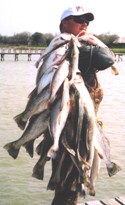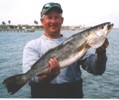|

| |
TRACKING THE TARPON
Strategies differ, not the trophy
By DOUG PIKE, Houston Chronicle June 27, 1996
Tarpon fishing is not a game of absolutes. The more vivid the imagination, the greater the
chance of coaxing a strike from this most exceptional fish.
Proof is everywhere, literally. Found in warm waters around the world, tarpon are chased
along open beachfronts, miles up tropical rivers and deep in mangrove snarls from
Galveston to Gabon. Local anglers in every port have favorite, proven fishing strategies,
and they're all different.
Along the Gulf Coast, plans mapped by the most successful tarpon anglers - essentially
chasing the same fish - vary from state to state, even zip code to zip code.
In some parts of Florida, for example, it's live mullet or nothing. In others, fresh dead
mullet get top honors. Elsewhere, it's pilchards or pinfish, live or dead. They'll chunk a
plug at a tarpon down in the Sunshine State, too, but rarely a jig.
Off the Louisiana coast, another outstanding tarpon venue, the Venice-based fleet almost
never throws natural baits. Not because fresh fish doesn't work, but because it works too
well - too many other, more aggressive species prowling alongside the tarpon .
Instead, Bayou State skippers typically pull spreads of Coon-Pops, which are jumbo-sized
curly tailed jigs.
Keen on stealth, Louisiana's tarpon fishermen go to great lengths to silence their engines
and slow their troll speeds.
Insulated engine compartments and inboard motors fitted with special reduction gears make
it possible to run virtually undetected, at barely one knot, over and alongside schools of
tarpon . When fish are located, the engines are disengaged, and the Coon-Pops fall through
the fish. Multiple hookups are common.
In Costa Rica, captains run outboard-powered skiffs and concentrate their efforts in open
ocean just off river mouths. They're not into natural baits at all.
The hottest plugs there are nondescript chunks of lead called Sea Hawks and Coast Hawks.
These baits cast a mile and sink like a rock, beneficial qualities often overlooked
elsewhere.
Along the upper Texas coast, most tarpon fishermen load their bait boxes with fresh
menhaden. Drifted through a chum slick, the oily baitfish are a proven favorite of tarpon
that average 100 pounds and can be more than twice that size.
In recent years, the handful of charter captains who work the nearshore Gulf from High
Island to Surfside also have had success with a variety of artificials.
The Term-Pop, a close cousin to its Louisiana counterpart but with a rattling head, has
earned its spurs, as have the 77-series Mirrolures.
What strikes me funny is that Texans don't fish the way Floridians fish, Louisianans don't
fish the way Texans fish, and so forth.
Each system works just well enough that skippers tend not to stray off the beaten path. On
tough days, though, it sometimes pays to reject the status quo.
When I met charter skipper Jim Leavelle and Trane Air Conditioning's Mark Cooley at
Teakwood Marina early Friday, I had none of the above in my bag. If a hungry tarpon came
my way, it would have to order off a different menu.
We were pinned to the dock for nearly an hour by a thunderhead that blacked the sky off
Galveston Island.
Weather radar showed movement to the east; we let the system slide past the Galveston
jetties and work its way well up the Bolivar Peninsula before getting underway.
Conditions in the wake of the storm were nearly ideal: green water, light wind and no
whitecaps. Leavelle turned his new 25-foot Hydra-Sports hard right just outside the south
jetty and poured the coals to twin 175s.
(An aside: The boat rode smoothly, like a Rolls Royce over uneven road, through two- and
three-foot head-on seas. In a slightly larger, quartering chop on the return, her deep-V
hull still rode like a Rolls - only as if we were going through a car wash with the
windows down.
(Leavelle thought maybe he wasn't dialing in the right combination of engine angle and
trim tab. I think he was being too hard on himself. We all thought about slicker suits.)
We ran past two free-jumping king mackerel and a smattering of bait to check an area about
halfway down the island. Water was even better there, a deep green from top to 40-foot
bottom, but lifeless. No bait, no birds, no nothing. One short drift produced a small
shark. Leavelle made a U-turn and headed back east.
The Galveston skyline rose on our left, and another king rocketed to the right. Thick pods
of baitfish showed on the fishfinder. Leavelle swung the boat and cut the engines.
He and Cooley threaded three big menhaden onto circle hooks and flipped them over the
side. One hung from a balloon, and two drifted free.
I settled at the bow and rigged a stiff popping rod and Ambassadeur 6500 (loaded with
fresh 20-pound Ande) with a 3 /8-ounce leadhead and six-inch chartreuse grub. Leavelle
snickered and shook his head, just as he always does when I venture into left field.
Loaded cameras ready, my real plan was to pick off a king or ling or jack crevalle - all
of which have been thick recently in the nearshore zone - while my partners waited for a
tarpon.
Half a dozen empty casts later, the jig was pitched one last time and allowed to drift on
the tide. The rod handle went between crossed legs as free hands worked the top off a
water bottle. Between gulps, I watched a yellow balloon bob on the surface.
Thump.
"Hey Jim, I think something hit my ..."
At that, the line went tight, the reel handle bore into my thigh, and a 60-pound tarpon
launched itself just off the bow. The tiny hook never found firm purchase.
When the fish slammed back to the water, the line fell slack. Before we could react, one
of the bait rods took a bow, and a 180-pound class tarpon cleared the Gulf. It, too, threw
the hook on reentry.
The third strike came within a minute of the first, and it stuck. Cooley grabbed the rod
and strapped himself into a fighting belt. The tug-of-war lasted nearly 40 minutes and
ended with the clean release of a 120-pound tarpon . By the numbers on Leavelle's GPS
unit, we'd been dragged nearly half a mile.
On the way back to ground zero, I swapped the undersized jig for a green/white DOA
Baitbuster, which carries a strong, single hook in its back - still a little small for
triple-digit tarpon , but imminently more qualified than the speckled trout-class jighead.
The Baitbuster got no special treatment and, like the jig, wound up in a lackluster crawl
along the bottom.
Leavelle sweetened the pot with a few bits of chum, and a brace of small sharks responded
quickly. Cooley was making fast work of the first when the second hit the rod nearest me.
With my light rod secured between tangled knees, I reached over and took a few cranks
against the unwelcomed blacktip.
And again, there came a sharp jolt on the artificial. While one hand kept the little shark
on a short leash, the other found its way around the popping rod just before a tarpon
crowding 100 pounds took flight.
Another 40-minute fight ensued, this one punctuated by half a dozen dramatic leaps. The
fish came boatside twice but was still too green for a clean grab of its thick lower lip.
Had we wanted to kill it - which was never a consideration and would have been illegal,
anyway, since I didn't have one of the Texas Parks and Wildlife Department's $100 tarpon
tags, and the fish wasn't near the 80-inch minimum size for retention - we could have.
By unanimous vote, the "catch" was counted. Then the tarpon turned hard away,
and the hook pulled free.
The final tally was two tarpon jumped on circle-hooked menhaden, two on artificials not
usually found in boxes loaded for the species. Importantly, the plastics didn't turn a
single shark.
"You might have just saved me a couple of thousand dollars in tackle and bait,"
said Leavelle, who goes through as many as 50 circle hooks and twice as many menhaden in a
busy day.
For anglers intent merely on bending a rod and catching any big fish, circle-hooked pogies
are a no-brainer. Those who target tarpon specifically but could live with the occasional
king, ling or jack should focus on jigs and plugs. Pick something that looks
"fishy," tie it on and take your chances.
Chunk and wind if it makes you feel more like a fisherman, but don't be surprised if the
best retrieve is no retrieve at all.
For more information on Texas tarpon fishing, call Leavelle at 667-8034.
-- DOUG PIKE, Houston Chronicle June 27, 1996
|
